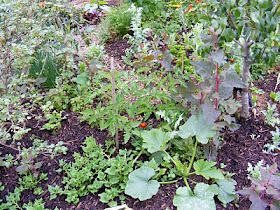So having looked at various quoted Oca yields (see down the page), I've done some calculations to allow comparison in garden-scale cultivation, based on growing on 4ft wide beds with 1ft wide paths. This means that each linear meter of bed occupies just over 1.5sq.m including access paths.
From a one-meter-run of 4ft wide bed, if you produce:-
- 14.55kg – You equal the world-wide highest claimed oca yield (that I can find).
- >6kg – You are up there with the white-coated men using select varieties, unlimited NPK, pesticides, irrigation, and often undisclosed, probably non-sustainable methods.
- 3 - 6kg – You match modern commercial producers, e.g. in New Zealand.
- 1.5 - 3kg – Good levels for traditional Andean peasant methods.
- 0.75 - 1.5kg – A poor effort for a peasant.
- < 0.75kg – Perhaps you are more cut out to be a hunter-gatherer.
With a monoculture system, planted at 6 plants per meter of bed, I'm confident I could achieve 6kg. But man cannot live by Oca alone.
Sources:
Average 7-10, maximum 40 tonnes/hectare.
5 tonnes/hectare (traditional Andean husbandry)
7-10 tonnes/hectare (commercial yields, Peru and New Zealand)
40 tonnes/hectare (experimental conditions)
Development of New Oca Lines in New Zealand. R.J. Martin, G.P. Savage, B.Deo, S.R.P. Hallow, P.J. Fletcher says:
Up to 20 tonnes/hectare (experimental).
Neglected Crops 1492 from a different perspective. J.E. Hernandez Bermejo, J. Leon says:
3-12 tonnes/hectare (average production, Peru). 97 tonnes/hectare (experimental selections and treatments)
Andean Tubers, C. Arizu and M. Tapia (CIP, Lima, Peru) says:
40-50 tonnes/hectare.
(1 tonne/ha = 0.1 kg/sq.m)






